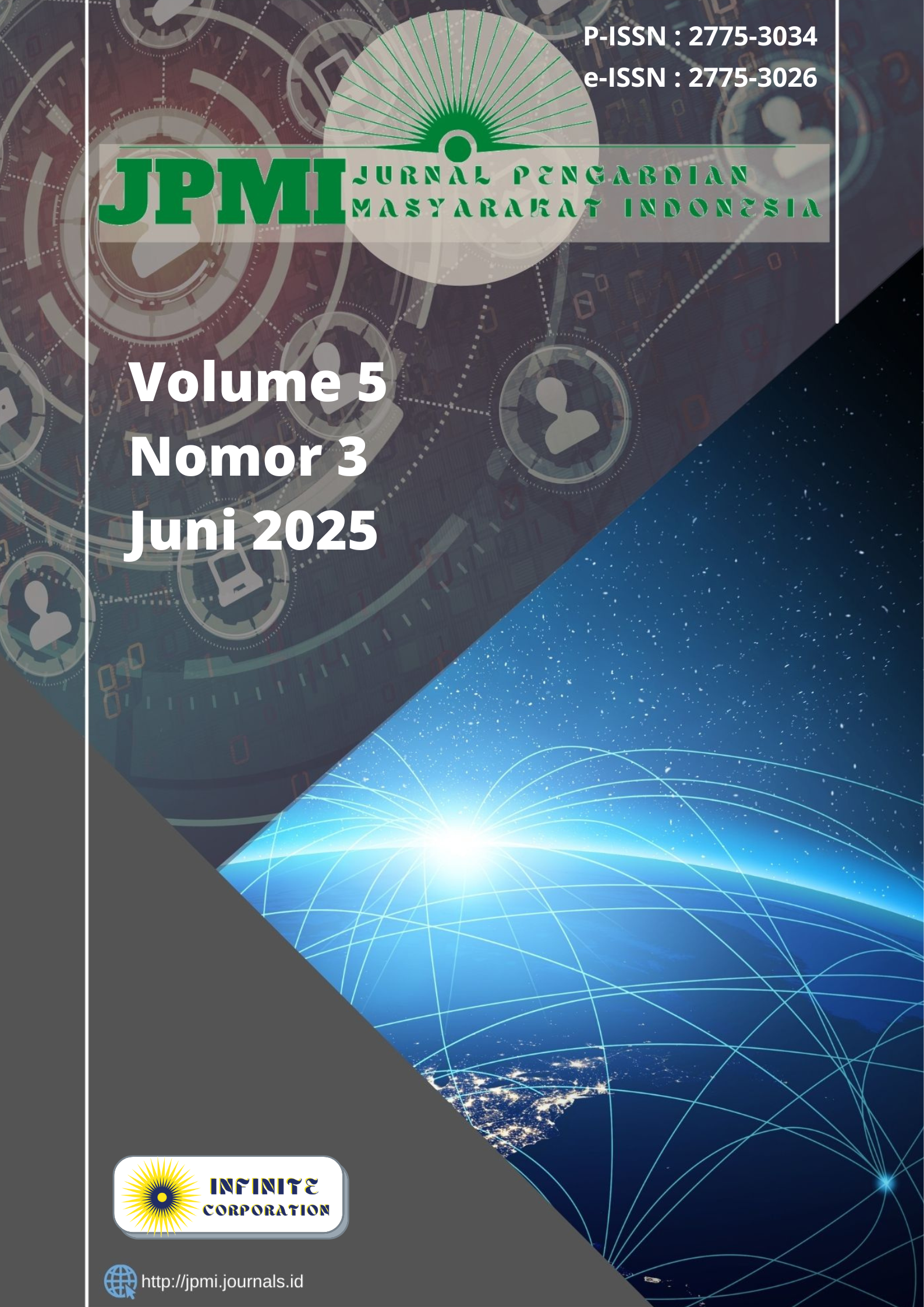Peran Modal Sosial dalam Memenuhi Kebutuhan Sosial dan Pemberdayaan Komunitas Berkelanjutan
DOI:
https://doi.org/10.52436/1.jpmi.3544Kata Kunci:
Bridging and Bonding, Keberlanjutan, Kebutuhan Sosial, Komunitas Sosial, Modal SosialAbstrak
Pengembangan masyarakat melalui pemberdayaan merupakan proses dinamis dan berkelanjutan. Bentuk pemberdayaan terhadap masyarakat dapat ditunjukan melalui kontribusi suatu komunitas sosial dalam mencapai kesejahteraan masyarakat yang ideal pada wilayah marginal di Jakarta. Artikel ini membahas tentang peran modal sosial bagi Komunitas Jakarta Mengabdi sebagai hal mendasar dalam meningkatkan dan memberdayakan well-being masyarakat, dengan mengimplementasikan pendekatan komunitas sosial dan keberhasilan diukur berdasarkan seberapa baik program-program tersebut memenuhi target yang telah ditentukan oleh Jakarta Mengabdi. Metode yang digunakan pada penelitian ini ialah wawancara mendalam dan observasi dengan pendekatan studi kasus yang berfokus kepada Komunitas Jakarta Mengabdi. Metode ini untuk mengukur efektifitas program komunitas terhadap pembangunan masyarakat. Selain itu, analisis dokumen Komunitas Jakarta Mengabdi dalam keberhasilan setiap program yang telah dijalankan. Pada artikel ini, peneliti menggunakan teori modal sosial bridging dan bonding Putnam dalam melihat pola hubungan yang dibangun oleh Jakarta Mengabdi dan masyarakat dalam proses pemberdayaan melalui modal sosial yang telah ditetapkan.
Unduhan
Referensi
G. Laverack, “Improving Health Outcomes through Community Empowerment: A Review of the Literature,” Journal of Health, vol. 24, no. 1, pp. 113–120, 2006, [Online]. Available: https://about.jstor.org/terms
Soetomo, Pembangunan masyarakat merangkai sebuah kerangka, 1st ed. Yogyakarta: Pustaka Pelajar, 2009.
B. Rudito, “The Improvement of Community Economy as Impact of Corporate Social Responsibility Program: A Case Study in Pengalengan, Bandung, West Java, Indonesia,” Procedia Soc Behav Sci, vol. 164, pp. 471–476, Dec. 2014, doi: 10.1016/j.sbspro.2014.11.104.
A. N. Ugwu and E. O. Aruma, “COMMUNITY PARTICIPATION AS A TOOL FOR THE PROMOTION OF SUSTAINABLE COMMUNITY DEVELOPMENT,” 2019. [Online]. Available: www.eajournals.org
R. Newell, I. Picketts, and A. Dale, “Community systems models and development scenarios for integrated planning: Lessons learned from a participatory approach,” Community Development, vol. 51, no. 3, pp. 261–282, May 2020, doi: 10.1080/15575330.2020.1772334.
F. Fukuyama, “Social Capital and Development,” Review, vol. 22, no. 1, pp. 23–37, 1989, doi: 10.2307/26996384.
J. W. Creswell and C. N. Poth, “Qualitative Inquiry & Research Design,” California, 2018.
I. Seidman, “Interviewing as Qualitative Research A Guide for Researchers in Education and the Social Sciences Third Edition,” New York, 2006.
W. L. (William L. Neuman, Social research methods?: qualitative and quantitative approaches, Seventh Edition., vol. Seventh Edition. England : Pearson Education Limited, 2014.
P. V. Marsden, “James Coleman, Social Capital, and Economic Sociology,” in Handbooks of Sociology and Social Research, 2017. doi: https://doi.org/10.1007/978-3-030-61619-9.
M. F. Mohiuddin, I. M. Yasin, A. R. Abdul Latiff, and M. Mannan, “Exploring the Impact of Bonding, Bridging and Linking Social Capital on Scaling Social Impact: An Emerging Economy Perspective,” Journal of Social Entrepreneurship, 2023, doi: 10.1080/19420676.2023.2263762.
H. Szemz?, J. Mosquera, L. Polyák, and L. Hayes, “Flexibility and Adaptation: Creating a Strategy for Resilience,” Sustainability (Switzerland), vol. 14, no. 5, Mar. 2022, doi: 10.3390/su14052688.
H. Coffé and B. Geys, “Toward an empirical characterization of bridging and bonding social capital,” 2007, SAGE Publications Inc. doi: 10.1177/0899764006293181.
B. F. Bichler and M. Lösch, “Collaborative governance in tourism: Empirical insights into a community-oriented destination,” Sustainability (Switzerland), vol. 11, no. 23, Dec. 2019, doi: 10.3390/su11236673.
R. Fathy, “Modal Sosial: Konsep, Inklusivitas dan Pemberdayaan Masyarakat,” Jurnal Pemikiran Sosiologi, pp. 1–17, 2019.
J. S. Coleman, “Social Capital in the Creation of Human Capital,” Chicago , 1988. [Online]. Available: https://www.jstor.org/stable/2780243
R. G. Boutilier, “Social Capital in Firm-Stakeholder Networks: A Corporate Role in Community Development,” The Journal of Corporate Citizenship, pp. 121–134, 2007, doi: 10.2307/jcorpciti.26.121.
C. L. Wagner and M. E. Fernandez-Gimenez, “Effects of community-based collaborative group characteristics on social capital,” Environ Manage, vol. 44, no. 4, pp. 632–645, Oct. 2009, doi: 10.1007/s00267-009-9347-z.
T. Claridge, “Functions-of-Social-Capital,” Social Capital Research, pp. 1–7, 2018.
J. M. Halstead, S. C. Deller, and K. M. Leyden, “Social capital and community development: Where do we go from here?,” Community Development, vol. 53, no. 1, pp. 92–108, 2022, doi: 10.1080/15575330.2021.1943696.
I. Gutierrez-Montes, M. Emery, and E. Fernandez-Baca, “The Sustainable Livelihoods Approach and the Community Capitals Framework: The Importance of System-Level Approaches to Community Change Efforts,” Community Development, vol. 40, no. 2, pp. 106–113, Jun. 2009, doi: 10.1080/15575330903011785.
M. Emery and C. Flora, “Spiraling-Up: Mapping Community Transformation with Community Capitals Framework,” Community Development, vol. 37, no. 1, pp. 19–35, Mar. 2006, doi: 10.1080/15575330609490152.
S. M. Kais and M. S. Islam, “Community capitals as community resilience to climate change: Conceptual connections,” Int J Environ Res Public Health, vol. 13, no. 12, Dec. 2016, doi: 10.3390/ijerph13121211.


























